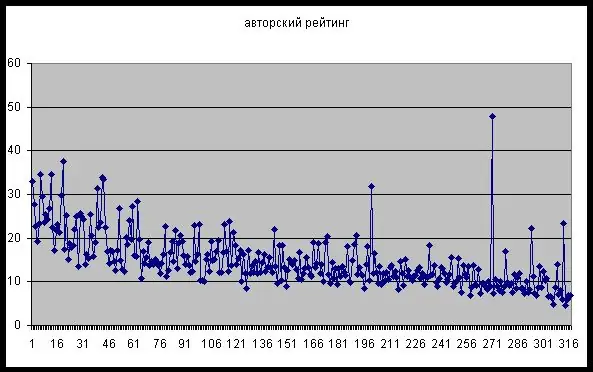Excel spreadsheet software offers tremendous opportunities for digital information processing. But no table can present the process as clearly as the graph of the function that describes it. In Excel there is also such a possibility in the menu item Insert - Chart (for Microsoft Office 2003).

Necessary
Microsoft Excel 2003 software
Instructions
Step 1
Open a blank sheet of workbook Microsoft Excel 2003. Think about the step with which you need to calculate the points on the graph of the function in the table. The more complex the graph of the function, the smaller the step you need to take for more accurate plotting. In the first column of the table for the values of the function argument, fill in the first two smallest values from the range of interest. After that select them with a block using the "mouse".
Step 2
Move the mouse cursor to the lower right corner of the selected range, it will take the form of a black cross. Press the left button and slide down, stopping the cursor at the end of the range of interest. This will create the function argument column. For example, if you need to get a graph of a function in the range (-10; 10) with a step of 0, 5, the first two values will be -10 and -9, 5, and you need to stop the cursor after the number 10 appears in the column.
Step 3
In order to build a column of values, in the cell adjacent to the smallest value of the argument, place the cursor and press "=". After that, type the formula of the function, instead of the argument (the "x" value), constantly clicking the "mouse" on the adjacent cell. After the formula is typed, press the Enter key. The value of the function for the argument from the first column appears in the cell. Place the cursor on this function value. Moving the mouse cursor to the lower right corner of the cell and seeing a black cross, drag it to the end of the range by pressing the left button. The column displays the function values corresponding to the arguments in the first column.
Step 4
Select "Insert" - "Chart" from the menu. In the window that opens, select "Spot". On the right side of the window, select the "Scatter chart with values connected by smooth lines without markers" chart view. Click "Next". In the window that opens, set a point on the "Rows in: columns" item. Click on the checkbox located to the right of the "Range" line and pressing the left mouse button select the entire range of arguments and values. Click on the tab of the same window "Series" and in the line "X values" with the "mouse" specify the range of arguments. Click the Next button twice, then Finish. The resulting graph will change based on changes in the formula. In other versions, the algorithm is similar and differs only in details.






